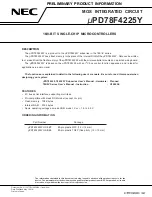UM10429
All information provided in this document is subject to legal disclaimers.
© NXP B.V. 2010. All rights reserved.
User manual
Rev. 1 — 20 October 2010
192 of 258
NXP Semiconductors
UM10429
Chapter 19: Appendix LPC1102 ARM Cortex-M0 reference
Sufficient priority means the exception has greater priority than any limit set by the mask
register, see
. An exception with less priority than this is pending but
is not handled by the processor.
When the processor takes an exception, unless the exception is a tail-chained or a
late-arriving exception, the processor pushes information onto the current stack. This
operation is referred to as
stacking
and the structure of eight data words is referred as a
stack frame
. The stack frame contains the following information:
Immediately after stacking, the stack pointer indicates the lowest address in the stack
frame. The stack frame is aligned to a double-word address.
The stack frame includes the return address. This is the address of the next instruction in
the interrupted program. This value is restored to the PC at exception return so that the
interrupted program resumes.
The processor performs a vector fetch that reads the exception handler start address from
the vector table. When stacking is complete, the processor starts executing the exception
handler. At the same time, the processor writes an EXC_RETURN value to the LR. This
indicates which stack pointer corresponds to the stack frame and what operation mode
the processor was in before the entry occurred.
If no higher priority exception occurs during exception entry, the processor starts
executing the exception handler and automatically changes the status of the
corresponding pending interrupt to active.
If another higher priority exception occurs during exception entry, the processor starts
executing the exception handler for this exception and does not change the pending
status of the earlier exception. This is the late arrival case.
19.3.3.6.2
Exception return
Exception return occurs when the processor is in Handler mode and execution of one of
the following instructions attempts to set the PC to an EXC_RETURN value:
•
a
POP
instruction that loads the PC
•
a
BX
instruction using any register.
The processor saves an EXC_RETURN value to the LR on exception entry. The
exception mechanism relies on this value to detect when the processor has completed an
exception handler. Bits[31:4] of an EXC_RETURN value are
0xFFFFFFF
. When the
processor loads a value matching this pattern to the PC it detects that the operation is a
Fig 42. Exception entry stack contents
SP points here before interrupt
x
PSR
PC
LR
R12
R3
R2
R1
R0
<previous>
SP points here after interrupt
SP + 0x1C
SP + 0x18
SP + 0x14
SP + 0x10
SP + 0x0C
SP + 0x08
SP + 0x04
SP + 0x00
Decreasing
memory
address


















